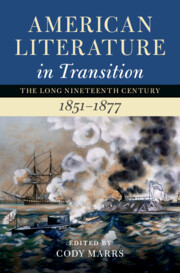44 results
Chapter 7 - The War Story
- from Part II - Histories
-
-
- Book:
- The Cambridge Companion to the American Short Story
- Published online:
- 11 May 2023
- Print publication:
- 25 May 2023, pp 117-130
-
- Chapter
- Export citation
19 - The Future of Civil War and Reconstruction Literature
- from Part II - Worlds Made and Remade
-
-
- Book:
- The Cambridge Companion to the Literature of the American Civil War and Reconstruction
- Published online:
- 04 August 2022
- Print publication:
- 18 August 2022, pp 284-294
-
- Chapter
- Export citation
1 - Material/Immaterial: Frederick Douglass and the ‘Moral Chemistry of the Universe’, 1855
-
-
- Book:
- Crossings in Nineteenth-Century American Culture
- Published by:
- Edinburgh University Press
- Published online:
- 26 November 2022
- Print publication:
- 30 June 2022, pp 19-28
-
- Chapter
- Export citation
Series Preface
-
- Book:
- American Literature in Transition, 1851–1877
- Published online:
- 15 June 2022
- Print publication:
- 23 June 2022, pp xvii-xviii
-
- Chapter
- Export citation
Copyright page
-
- Book:
- American Literature in Transition, 1851–1877
- Published online:
- 15 June 2022
- Print publication:
- 23 June 2022, pp iv-iv
-
- Chapter
- Export citation
Figures
-
- Book:
- American Literature in Transition, 1851–1877
- Published online:
- 15 June 2022
- Print publication:
- 23 June 2022, pp viii-viii
-
- Chapter
- Export citation
Part III - Exchanges
-
- Book:
- American Literature in Transition, 1851–1877
- Published online:
- 15 June 2022
- Print publication:
- 23 June 2022, pp 205-270
-
- Chapter
- Export citation
Introduction
-
-
- Book:
- American Literature in Transition, 1851–1877
- Published online:
- 15 June 2022
- Print publication:
- 23 June 2022, pp 1-10
-
- Chapter
- Export citation
Part IV - The Long Civil War
-
- Book:
- American Literature in Transition, 1851–1877
- Published online:
- 15 June 2022
- Print publication:
- 23 June 2022, pp 271-355
-
- Chapter
- Export citation
Contributors
-
- Book:
- American Literature in Transition, 1851–1877
- Published online:
- 15 June 2022
- Print publication:
- 23 June 2022, pp ix-xvi
-
- Chapter
- Export citation
Part I - Careers
-
- Book:
- American Literature in Transition, 1851–1877
- Published online:
- 15 June 2022
- Print publication:
- 23 June 2022, pp 11-124
-
- Chapter
- Export citation
Part II - Networks
-
- Book:
- American Literature in Transition, 1851–1877
- Published online:
- 15 June 2022
- Print publication:
- 23 June 2022, pp 125-204
-
- Chapter
- Export citation
Index
-
- Book:
- American Literature in Transition, 1851–1877
- Published online:
- 15 June 2022
- Print publication:
- 23 June 2022, pp 356-358
-
- Chapter
- Export citation
Contents
-
- Book:
- American Literature in Transition, 1851–1877
- Published online:
- 15 June 2022
- Print publication:
- 23 June 2022, pp v-vii
-
- Chapter
- Export citation

American Literature in Transition, 1851–1877
-
- Published online:
- 15 June 2022
- Print publication:
- 23 June 2022
Chapter 9 - The Civil War in African American Memory
- from Part III - Memories, Materialities, and Locations
-
-
- Book:
- African American Literature in Transition, 1865–1880
- Published online:
- 18 March 2021
- Print publication:
- 13 May 2021, pp 213-232
-
- Chapter
- Export citation
Chapter 9 - Dickinson’s Physics
- from Part III - Nineteenth-Century Histories
-
-
- Book:
- The New Emily Dickinson Studies
- Published online:
- 09 May 2019
- Print publication:
- 16 May 2019, pp 155-167
-
- Chapter
- Export citation
Index
-
- Book:
- The New Melville Studies
- Published online:
- 01 March 2019
- Print publication:
- 21 March 2019, pp 275-280
-
- Chapter
- Export citation
Select Bibliography
-
- Book:
- The New Melville Studies
- Published online:
- 01 March 2019
- Print publication:
- 21 March 2019, pp 269-274
-
- Chapter
- Export citation
Abbreviations for Texts Cited
-
- Book:
- The New Melville Studies
- Published online:
- 01 March 2019
- Print publication:
- 21 March 2019, pp xii-xii
-
- Chapter
- Export citation



